|
|
|
Sort Order |
|
|
|
Items / Page
|
|
|
|
|
|
|
| Srl | Item |
| 1 |
ID:
178418
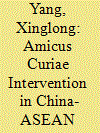

|
|
|
|
|
| Summary/Abstract |
One main criticism levelled against the investor-state dispute settlement system (ISDS) is the existence of limited opportunities for amicus intervention. Against this backdrop, this article firstly studies what reforms regarding amicus intervention in ISDS proceedings have been put forward by China and ASEAN countries and the relevant dilemmas. Subsequently, to ensure that maximum benefits can be realised from amicus participation in ISDS proceedings in China-ASEAN Free Trade Area (CAFTA), this article proposes procedures for when and how an amicus may participate in arbitral proceedings under the upcoming investment agreements, particularly the Regional Comprehensive Economic Partnership (RCEP). Additionally, given the fact that the level of amicus participation in ISDS proceedings is still limited, the article suggests that China and ASEAN need to establish safeguards to provide amici with access to key arbitral documents and oral hearings. However, achieving the above objectives should not come at the expense of undermining the confidential and protected information of both disputing parties.
|
|
|
|
|
|
|
|
|
|
|
|
|
|
|
|
| 2 |
ID:
172455
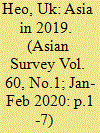

|
|
|
|
|
| Summary/Abstract |
Among the major events that occurred in Asia in 2019 were four that received global attention: the Regional Comprehensive Economic Partnership (RCEP), the US-China trade war, the North Korean nuclear issue, and protests in Hong Kong. These events have significant policy implications for the world as well as for Asia.
|
|
|
|
|
|
|
|
|
|
|
|
|
|
|
|
| 3 |
ID:
138926
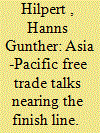

|
|
|
|
|
| Summary/Abstract |
Asia is not only the world’s most dynamic region in terms of trade, it is also an important pacesetter in trade policy. The USA is currently negotiating with 11 partner countries over a Trans-Pacific Partnership (TPP); the members of the ASEAN+6 group are in talks over a Regional Comprehensive Economic Partnership (RCEP), while Japan, China and Korea are conducting trilateral trade negotiations (China-Japan-Korea Free Trade Agreement (CJK FTA)). The multilateral structures emerging from all these initiatives could, in the long term, be combined into a Free Trade Area of the Asia-Pacific (FTAAP). What are the motives behind these agreements? What are their chances of being implemented? When it comes to the trade and geopolitical power struggle that encompasses these talks, does the USA or China have the upper hand? And what role remains for Europe’s trade policy?
|
|
|
|
|
|
|
|
|
|
|
|
|
|
|
|
| 4 |
ID:
142783
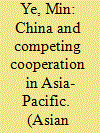

|
|
|
|
|
| Summary/Abstract |
A big question looming large over policy and theory in Asian security is how China will use its newfound wealth and power in the region and with what consequences. The United States has concluded the negotiation of Trans-Pacific Partnership (TPP); ASEAN has promoted the Regional Comprehensive Economic Partnership (RCEP). Both frameworks seek to shape China’s regional behavior and manage rising China. In late 2013, China inaugurated the new Silk Road initiative, which has rapidly gained momentum in the country and among China’s neighbors. American public and policy makers, however, are largely unaware or baffled by the new Silk Road. The article, based on field surveys and extensive documentary analysis, provides the first roadmap on how China views TPP, RCEP, and the new Silk Road. It offers important exploration of how China acts and reacts to regional contestation and what are implications for the region.
|
|
|
|
|
|
|
|
|
|
|
|
|
|
|
|
| 5 |
ID:
137274
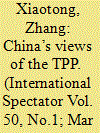

|
|
|
|
|
| Summary/Abstract |
The Chinese policy and academic communities have mixed views about the US-led TPP, either viewing it as a strategic attempt at encircling China, or as a positive spur for domestic reform and opening-up. Although the Chinese government adopted an open and flexible attitude towards the TPP, it has moved strategically by accelerating the negotiations of the RCEP and China–Korea FTA, as well as updating its FTA with ASEAN. A more interesting development is China’s new initiatives for building two grand silk roads, one to Central Asia, leading on to Europe, and the other to Southeast Asia, leading on to the Indian Ocean. Both represent China’s renewed confidence in finding its role in Asia.
|
|
|
|
|
|
|
|
|
|
|
|
|
|
|
|
| 6 |
ID:
188154


|
|
|
|
|
| Summary/Abstract |
The Regional Comprehensive Economic Partnership (RCEP) agreement was signed on November 15, 2020. This marks the formal conclusion of the world's largest free trade agreement in terms of population and economic scale. The RCEP agreement covers new liberalization commitments in goods, services, investment, and movement of natural persons, and addresses some emerging behind-the-border trade issues, to forge more transparent, open, and inclusive trade rules. Its aim is to build a comprehensive, modern, inclusive, and high-quality free trade agreement. This paper summarizes the framework and highlights of the RCEP agreement, measures the extent of tariff reduction from various perspectives, makes a quantitative assessment of the level of service trade liberalization of the member states adopting positive list commitments, and makes an in-depth analysis of trade rules and provisions in the RCEP agreement. Furthermore, this paper also makes a comprehensive comparison of main provisions among the Comprehensive and Progressive Agreement for Trans-Pacific Partnership, RCEP, and US-Mexico-Canada Agreement. The paper concludes with policy recommendations for China to promote the implementation of the RCEP agreement.
|
|
|
|
|
|
|
|
|
|
|
|
|
|
|
|
| 7 |
ID:
141940
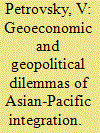

|
|
|
|
|
| Summary/Abstract |
ECONOMIC INTEGRATION in the APR has come close to fundamental qualitative changes launched by the emerging mechanisms of multi-sided integration in trade and economies. In November 2014, in Beijing the APEC summit discussed a future Free Trade Area of the Asia-Pacific (FTAAP), a Regional Comprehensive Economic Partnership (RCEP) on the basis of ASEAN and its partners, and a Trans-Pacific Partnership (TPP) lobbied by the U.S.
|
|
|
|
|
|
|
|
|
|
|
|
|
|
|
|
| 8 |
ID:
146906
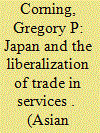

|
|
|
|
|
| Summary/Abstract |
This paper argues that political rather than economic motivations explain Japan’s approach to services negotiations but that the Trans-Pacific Partnership and Trade in Services Agreement present Japan with opportunities to advance liberalization in services as well as to pursue political gains in the competition for regional leadership with China.
|
|
|
|
|
|
|
|
|
|
|
|
|
|
|
|
| 9 |
ID:
168514
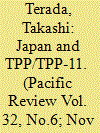

|
|
|
|
|
| Summary/Abstract |
Based on the neoclassical realism approach, this article aims to clarify factors conducive to Japan’s different roles in both participating in the trans-pacific partnership (TPP) and concluding the TPP-11 by focusing on how the US’s distinctive attitudes towards the TPP under the Obama and Trump administrations influenced Japan’s changing approaches. During the Obama administration, which needed Japan’s participation to expand the TPP in the face of China’s growing global and regional economic influence, Japan incorporated the TPP into its growth strategy and committed itself to sustaining US leadership during TPP negotiations by making necessary concessions on both the international and domestic fronts. By contrast, the Trump administration, with its strong propensity for bilateral deals to counter China’s bid for global economic hegemony with the TPP withdrawal urged Japan to change its reactive stance and take a proactive role in TPP-11 negotiations. This article opens a ‘black box’ of the political system under the second administration of Shinzo Abe, and demonstrates the strengthened function of the Prime Minister’s Office and Cabinet Secretariat or Kantei within the centralised trade policy-making apparatus as key mechanisms contributing to a departure from the traditional features that occasionally hampered Japan’s foreign economic policy initiatives.
|
|
|
|
|
|
|
|
|
|
|
|
|
|
|
|
| 10 |
ID:
171724


|
|
|
|
|
| Summary/Abstract |
This article seeks to understand why India may have decided to withdraw
from the Regional Comprehensive Economic Partnership (RCEP) as
was announced at the third RCEP summit meeting held in Bangkok on
4 November 2019. It also examines briefly the possible implications of
this decision, particularly in the present context of looming challenges
on the international trade front. It explores possible options for India
and what its priorities could be. Finally, in the event that there may be
a re-consideration by India about joining RCEP, what could be some of
the guiding elements?
|
|
|
|
|
|
|
|
|
|
|
|
|
|
|
|
| 11 |
ID:
169804


|
|
|
|
|
| Summary/Abstract |
In the East Asia Summit meeting concluded in early November 2019 in Bangkok where the issue of concluding the much-hyped Regional Comprehensive Economic Partnership (RCEP) agreement found centre stage, India decided to opt out, saying its key concerns were not addressed. Making a forceful argument in his address at the RCEP summit, Indian Prime Minister Narendra Damodardas Modi remarked: “The present form of the RCEP Agreement does not fully reflect the basic spirit and the agreed guiding principles of RCEP”. Elaborating his argument further, he said: “It also does not address satisfactorily India’s outstanding issues and concerns. In such a situation, it is not possible for India to join RCEP Agreement.” Let me explain.
|
|
|
|
|
|
|
|
|
|
|
|
|
|
|
|
| 12 |
ID:
177303


|
|
|
|
|
| Summary/Abstract |
On November 15, 2020, ASEAN and China, Japan, Republic of Korea (ROK), Australia and New Zealand, a total of 15 countries, signed the Regional Comprehensive Economic Partnership (RCEP) Agreement, which not only marks a new stage of regional economic integration in Asia, but also creates a new platform for deepening cooperation and building a community with a shared future between China and ASEAN in the post-COVID era.
|
|
|
|
|
|
|
|
|
|
|
|
|
|
|
|
| 13 |
ID:
175650


|
|
|
|
|
| Summary/Abstract |
After more than 12 rounds of negotiations, at the 35th Association of Southeast Asian Nations (ASEAN) Summit and the third Regional Comprehensive Economic Partnership (RCEP) Summit held jointly in Bangkok, Thailand on 4 November 2019, India declared that it had decided to exit the RCEP. The RCEP is a proposed trade agreement between ASEAN and China, Japan, South Korea, Australia and New Zealand. The five countries have a free trade agreement (FTA) with ASEAN. The RCEP intends to increase trade and commerce by providing greater market access for countries that do not have FTAs with the bloc countries, providing investment opportunities for the bloc countries, reducing tariffs and other barriers and standardising customs rules and procedures. It will also help in setting up supply chains in the RCEP countries to export goods outside the bloc which will further enhance economic growth. The RCEP is the largest trading bloc in the world, larger than the European Union (EU) and the region covered by the US–Mexico–Canada trade agreement. It accounts for approximately one-third of the world’s population and one-third of the global gross domestic product (GDP).
|
|
|
|
|
|
|
|
|
|
|
|
|
|
|
|
| 14 |
ID:
182608


|
|
|
|
|
| Summary/Abstract |
India and the Association of Southeast Asian Nations’ (ASEAN) partnership began in the early 1990s mainly in the economic domain. Reeling from a major internal crisis, India wanted to tap onto the region’s economic vibrancy to strengthen its own waning economy. Since then, amidst India’s domestic constraints, economic ties have largely sustained the India–ASEAN partnership on a steady course. India’s withdrawal from the ASEAN-led Regional Comprehensive Economic Partnership (RCEP) negotiations in 2019, therefore, was an important inflection point in the partnership. This study, hence, discusses the prospects for the India–ASEAN partnership moving forward beyond the RCEP. This is undertaken by first examining the main challenges India faces with the ASEAN Free Trade Arrangement and the RCEP. After which, relevant developments pertaining to India’s multilateral partnership within the Indo-Pacific theatre as well as to India’s economic trajectory are deliberated in relation to ASEAN. Based on this analysis, this study argues that the outlook for India–ASEAN ties remains optimistic since the external and internal pressures needed for important economic reforms has not diminished for India. In addition, there are prospects for wider engagements with ASEAN due to Indo-Pacific-related strategic recalibrations in the region. Therefore, collectively these factors will provide crucial thrusts for the partnership to move forward strongly sans RCEP.
|
|
|
|
|
|
|
|
|
|
|
|
|
|
|
|
| 15 |
ID:
149053
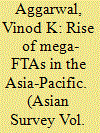

|
|
|
|
|
| Summary/Abstract |
This special issue focuses on the rise of mega-FTAs—which involve efforts to liberalize trade across geographical regions with a multiplicity of countries—in the Asia-Pacific. We examine how the Trans-Pacific Partnership and the Regional Comprehensive Economic Partnership in this region have faced political resistance as negotiators attempt to address behind-the-border issues.
|
|
|
|
|
|
|
|
|
|
|
|
|
|
|
|
| 16 |
ID:
146412
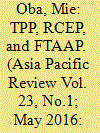

|
|
|
|
|
| Summary/Abstract |
In the Asia-Pacific region, multiple efforts to facilitate economic integration and cooperation are underway. The various frameworks come in a range of scale and scope, membership, and degree of clarity. ASEAN member countries, in a variety of combinations, are party to these trade agreements. Overlapping and multilayered, these frameworks are venues for both creating large economic areas as well as for competition for regional leadership. Besides the international dimension, the domestic situations of each participating member country affect the process of negotiations and achievement of the agreements.
|
|
|
|
|
|
|
|
|
|
|
|
|
|
|
|
| 17 |
ID:
139480
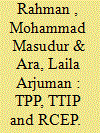

|
|
|
|
|
| Summary/Abstract |
The Transatlantic Trade and Investment Partnership (TTIP), the Trans-Pacific Partnership (TPP) and the Regional Comprehensive Economic Partnership (RCEP) could be the biggest trade deals in history. As the European Union (EU), the United States (US) and RCEP countries are the biggest trading partner of all South Asian countries, such preferential tariff arrangements could lead to a significant erosion of preferences enjoyed currently by the South Asian countries. Against this backdrop, the main objective of the present study is to investigate the potential economic impacts of tariff eliminations under TPP, TTIP and RCEP on South Asian countries using a standard computable general equilibrium model. The analysis evinces that under complete integration, in terms of tariff elimination, under these three mega deals, the excluded South Asian countries could face a tremendous negative impact on their economies. The analysis also suggests that South Asia may consider joining the TPP to minimize the negative economic impact due to arise from these mega deals.
|
|
|
|
|
|
|
|
|
|
|
|
|
|
|
|
| 18 |
ID:
182607


|
|
|
|
|
| Summary/Abstract |
India dropped out of the Regional Comprehensive Economic Partnership (RCEP)—which included the Association of Southeast Asian Nations (ASEAN) countries, China, South Korea, New Zealand, Japan and Australia—after negotiating for almost seven years in November 2018 on the grounds of national interest and also that free trade agreements (FTAs) did not amount to free trade and led to more trade diversion than trade creation. The cost and benefit of a regional agreement depend on the amount of trade creation with respect to trade diversion (Panagriya, 2000). This study tries to examine India’s concerns and, at the same time, highlights the cost of not joining RCEP. India’s trade deficit with 11 out of the 15 RCEP nations has been a major cause of concern. Unfavourable trade balance, concerns about the impact on dairy sector, economic slowdown, past experience with FTA’s, China factor, data localisation, rules of origin and the experience of ASEAN countries with Sino-FTA have been some of the reasons behind India’s decision to opt out of this mega multilateral agreement. Also, bilateral trade agreements with some RCEP countries such as Japan, Malaysia, Singapore, Thailand and South Korea were operational. A multilateral trade agreement with ASEAN countries was very much in place. So, trade between India and 12 of the RCEP member countries would not have changed much after India’s inclusion in the RCEP. The impact of lower tariffs would have been evident for the remaining three countries: China, Australia and New Zealand. Furthermore, there was fear of a massive surge in imports of manufactures from China and dairy imports from Australia and New Zealand. This study also examines the long-term impact of this decision and if India has missed out on becoming a part of the global value chain and gaining greater market access in the Asia-Pacific region. India’s policy of import substitution and protectionism did not capitulate desired results in the past. Hence, a critical evaluation of India’s decision and some validation on her concerns and fears have been done.
|
|
|
|
|
|
|
|
|
|
|
|
|
|
|
|
| 19 |
ID:
186843
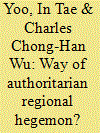

|
|
|
|
|
| Summary/Abstract |
How has China contributed toward the conclusion of the Regional Comprehensive Economic Partnership (RCEP)? The extant literature tends to either undervalue China’s role or emphasizes the absence of China’s willingness to realize the RCEP. However, it is difficult to form region-wide multilateral preferential trade agreements (PTAs), such as RCEP, without any significant contribution from a regional hegemon, such as China. This paper, thus, argues that China has contributed significantly toward the conclusion of RCEP by engendering incentives for member countries to join through multiple cooperative structures. These cooperative structures involve China-led bilateral PTAs and international development forums, which include the Belt and Road Initiative and Asian Infrastructure Investment Bank. With the gradual shift from bilateral to multilateral PTAs and forum-linkage strategies, China turned to be more assertive in concluding the RCEP than in the early years of RCEP negotiations, as evidenced by the discourse of political and opinion leaders.
|
|
|
|
|
|
|
|
|
|
|
|
|
|
|
|
| 20 |
ID:
140518


|
|
|
|
|
| Summary/Abstract |
Because of rapid economic growth and close economic interdependence, East Asia has recently been in the spotlight of regional integration theorists. Currently, East Asia is being remapped in two ways: one is the Regional Comprehensive Economic Partnership (RCEP); and the other is the Trans-Pacific Strategic Economic Partnership (TPP). This article aims at predicting the winner of inter-institutional balancing between the two tracks from a viewpoint of power politics. To do so, realist hypotheses are made of regional integration and they are tested against the Integration Achievement Score (IAS) data. As a result, newly suggested hypotheses and some conventional ideas are strongly supported. These findings hold, regardless of model specifications and measurement of variables. Next, after analyzing how much the RCEP and the TPP accord with those findings, probabilities are presented showing that the two tracks can achieve regional economic integration. In conclusion, the TPP is expected to become the winner of inter-institutional balancing.
|
|
|
|
|
|
|
|
|
|
|
|
|
|
|
|
|
|
|
|
|